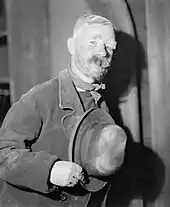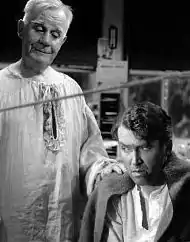Henry Travers
Travers John Heagerty[1] (5 March 1874[2] – 18 October 1965), known by the stage name Henry Travers, was an English film and stage character actor. His most famous role was the guardian angel Clarence Odbody in the 1946 film classic It's a Wonderful Life. He also received an Academy Award nomination for his supporting role in Mrs. Miniver (1942). Travers specialized in portraying slightly bumbling but friendly and lovable old men.
Henry Travers | |
|---|---|
 Travers in The Bells of St. Mary's (1945) | |
| Born | Travers John Heagerty 5 March 1874 Prudhoe, Northumberland, England |
| Died | 18 October 1965 (aged 91) Hollywood, California, U.S. |
| Occupation | Actor |
| Years active | 1894–1949 |
| Spouse(s) | Amy Forrest-Rhodes
(m. 1931; died 1954)Anna (Ann) Glud Murphy
(m. 1955; |
Life and career
Early life
Travers was born in Prudhoe, Northumberland, and was the son of Daniel Heagerty,[2] a doctor originally from Ireland, and Ellen Gillman Hornibrook Belcher. His mother was a native of County Cork, Ireland, and was previously married to William H. Belcher, a merchant seaman. He died in 1869. Travers had a half-brother, Samuel William Belcher, by his mother's previous marriage. He also had another brother, Daniel George Belsaigne Heagerty, and a sister, Mary Sophia Maude Heagerty. Travers grew up in Berwick-upon-Tweed, and many biographies wrongly report him as being born there.[3] [4]
The Travers family lived in Prudhoe for a couple of years before moving from Woodburn, on the A68 road near Corsenside, Northumberland, in about 1866, to Tweedmouth, Berwick-upon-Tweed, in about 1876.
Initially, he trained as an architect[2] at Berwick, before taking to the stage under the name Henry Travers.
Acting career


Travers gained early experience acting in repertory theatre in England.[5] He was billed as Travers Heagerty for a December 1895 production.[6] He played character roles almost from the beginning of his acting career in 1894, often figures who were much older than himself.[7] He made his Broadway debut in The Price of Peace (1901)[8] but returned to England. Travers again went to the United States in 1917 after a long and successful theatre career in his homeland. He played frequently from November 1917 until December 1938 on Broadway in over 30 plays, and was described in the The New Yorker as 'one of the most consistent performers now in the American theatre, and at the same time one of its least appreciated'.[9]His last play on Broadway You Can't Take It with You was his most famous, where he acted in over 380 performances in two years. In the Oscar-winning movie You Can't Take It With You, Lionel Barrymore played the role which Travers had portrayed on Broadway.
Like many other theatre actors, he made his first movie only with the advent of sound films. His first was Reunion in Vienna[5] in 1933. In the same year, he played the father of Gloria Stuart in the horror classic The Invisible Man. He often portrayed doctors, judges, and fathers of the main figures in supporting roles. Travers specialized on portraying slightly wry and bumbling but friendly and lovable old men. He appeared with Greer Garson and Ronald Colman in Random Harvest (1942) and with Bing Crosby and Ingrid Bergman in The Bells of St. Mary's (1945). Alfred Hitchcock used Travers as a Comic relief in Shadow of a Doubt (1943), where he played a bank clerk with a passion for criminal magazines. The character actor also portrayed the Railway Station Master Mr. Ballard with a love for roses who finally wins the annual flower show in his village shortly before dying in a bombardment in Mrs. Miniver. He received an Academy Award-nomination as Best Supporting Actor for this appearance.
Travers's most famous role was as James Stewart's somewhat befuddled but kind-hearted guardian angel Clarence Odbody in Frank Capra's 1946 film It's a Wonderful Life. Travers' character saves Stewart's from committing suicide, and shows him how wonderful his life really is. Though the film was a financial flop, it later became a Christmas classic and one of the most beloved films in American cinema. However, despite his long life, Travers would never know that his performance as Clarence would become his most celebrated, as the film only became a Christmas television perennial in the 1970s and 1980s, long after the actor's death.
Travers retired in 1949 after his supporting role in The Girl From Jones Beach. Overall, he acted in 52 films.
Personal life and death
Travers' first wife was actress Amy Forrest-Rhodes (1881–1954). They were married from 1931 until her death in 1954. In 1955, he married Ann G. Murphy (1899–1983) who survived him.[2]
After several years in retirement, Travers died as a result of arteriosclerosis in 1965, at the age of 91. He is buried with his second wife in the Forest Lawn Memorial Park, Glendale.
Filmography

- Reunion in Vienna (1933) as Father Krug
- Another Language (1933) as Pop Hallan
- My Weakness (1933) as Ellery Gregory
- The Invisible Man (1933) as Dr. Cranley
- Death Takes a Holiday (1934) as Baron Cesarea
- Born to Be Bad (1934) as Fuzzy
- The Party's Over (1934) as Theodore
- Ready for Love (1934) as Judge Pickett
- Maybe It's Love (1935) as Mr. Halevy
- After Office Hours (1935) as Cap
- Captain Hurricane (1935) as Capt. Ben
- Four Hours to Kill! (1935) as Mac Mason
- Escapade (1935) as Concierge
- Pursuit (1935) as Thomas 'Tom' Reynolds
- Seven Keys to Baldpate (1935) as Adalbert 'Lem' Peters / The Hermit
- Too Many Parents (1936) as Wilkins
- The Sisters (1938) as Ned Elliott
- You Can't Get Away with Murder (1939) as Pop
- Dodge City (1939) as Dr. Irving
- Dark Victory (1939) as Dr. Parsons
- On Borrowed Time (1939) as Dr. Evans
- Stanley and Livingstone (1939) as John Kingsley
- The Rains Came (1939) as Rev. Homer Smiley
- Remember? (1939) as Judge Milliken
- Primrose Path (1940) as Gramp
- Edison, the Man (1940) as Ben Els
- Anne of Windy Poplars (1940) as Matey
- Wyoming (1940) as Sheriff
- High Sierra (1941) as Pa
- A Girl, a Guy and a Gob (1941) as Abel Martin
- The Bad Man (1941) as Mr. Hardy
- I'll Wait for You (1941) as Mr. Miller
- Ball of Fire (1941) as Prof. Jerome
- Mrs. Miniver (1942) as Mr. Ballard
- Pierre of the Plains (1942) as Percival Wellsby
- Random Harvest (1942) as Dr. Sims
- Shadow of a Doubt (1943) as Joseph Newton
- The Moon Is Down (1943) as Mayor Orden
- Madame Curie (1943) as Eugene Curie
- None Shall Escape (1944) as Father Warecki
- Dragon Seed (1944) as Third Cousin
- The Very Thought of You (1944) as Pop Wheeler
- Thrill of a Romance (1945) as Hobart Glenn
- The Naughty Nineties (1945) as Capt. Sam Jackson
- The Bells of St. Mary's (1945) as Horace P. Bogardus
- Gallant Journey (1946) as Thomas Logan
- The Yearling (1946) as Mr. Boyles
- It's a Wonderful Life (1946) as Clarence Odbody
- The Flame (1947) as Dr. Mitchell
- Beyond Glory (1948) as Pop Dewing
- The Accused (1949) as Blakely, Romley's Assistant (uncredited)
- The Girl From Jones Beach (1949) as Judge Bullfinch (final film role)
References
- Room, Adrian (2014). Dictionary of Pseudonyms: 13,000 Assumed Names and Their Origins, 5th ed. McFarland. p. 480. ISBN 9780786457632. Retrieved 20 July 2019.
- Gordon, Dr Roger L. (2018). Supporting Actors in Motion Pictures. Dorrance Publishing. pp. 18–19. ISBN 9781480944992. Retrieved 20 July 2019.
- GRO Register of Births, Marriages and Death and 1881 Census for England & Wales
- Armstrong, Jeremy (27 December 2015). "Did you know one of the most famous Christmas angels was born in Prudhoe?". Retrieved 17 January 2017.
- Monush, Barry (2003). Screen World Presents the Encyclopedia of Hollywood Film Actors: From the silent era to 1965. Hal Leonard Corporation. p. 741. ISBN 9781557835512. Retrieved 20 July 2019.
- "Berwick". The Era. England, London. 21 December 1895. p. 20. Retrieved 20 July 2019 – via Newspapers.com.
- "Movie Reviews". 18 July 2019 – via NYTimes.com.
- "("Henry Travers" search results)". Internet Broadway Database. The Broadway League. Archived from the original on 20 July 2019. Retrieved 20 July 2019.
- The New Yorker, Dec 5 1925, p 14, in a review of Androcles.
External links
| Wikimedia Commons has media related to Henry Travers. |
- Henry Travers at IMDb
- Henry Travers on television
- Henry Travers at the Internet Broadway Database

- Henry Travers at Find a Grave
